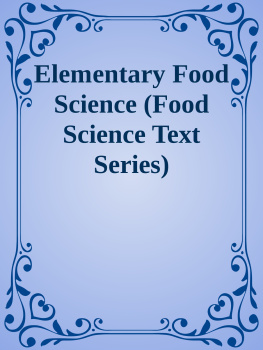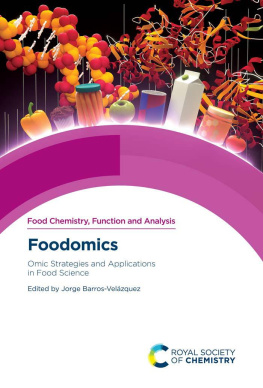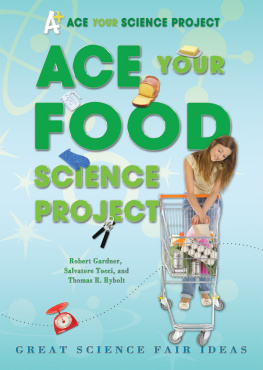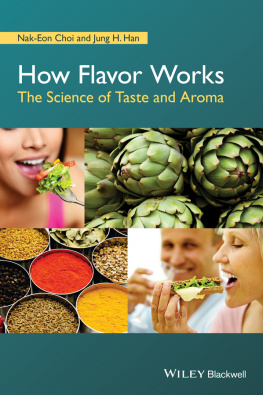Food Science and the Culinary Arts
First Edition
Mark Gibson
Illustrated by
Pat Newsham

Copyright
Academic Press is an imprint of Elsevier
125 London Wall, London EC2Y 5AS, United Kingdom
525 B Street, Suite 1800, San Diego, CA 92101-4495, United States
50 Hampshire Street, 5th Floor, Cambridge, MA 02139, United States
The Boulevard, Langford Lane, Kidlington, Oxford OX5 1GB, United Kingdom
2018 Elsevier Inc. All rights reserved.
No part of this publication may be reproduced or transmitted in any form or by any means, electronic or mechanical, including photocopying, recording, or any information storage and retrieval system, without permission in writing from the publisher. Details on how to seek permission, further information about the Publishers permissions policies and our arrangements with organizations such as the Copyright Clearance Center and the Copyright Licensing Agency, can be found at our website: www.elsevier.com/permissions.
This book and the individual contributions contained in it are protected under copyright by the Publisher (other than as may be noted herein).
Notices
Knowledge and best practice in this field are constantly changing. As new research and experience broaden our understanding, changes in research methods, professional practices, or medical treatment may become necessary.
Practitioners and researchers must always rely on their own experience and knowledge in evaluating and using any information, methods, compounds, or experiments described herein. In using such information or methods they should be mindful of their own safety and the safety of others, including parties for whom they have a professional responsibility.
To the fullest extent of the law, neither the Publisher nor the authors, contributors, or editors, assume any liability for any injury and/or damage to persons or property as a matter of products liability, negligence or otherwise, or from any use or operation of any methods, products, instructions, or ideas contained in the material herein.
Library of Congress Cataloging-in-Publication Data
A catalog record for this book is available from the Library of Congress
British Library Cataloguing-in-Publication Data
A catalogue record for this book is available from the British Library
ISBN: 978-0-12-811816-0
For information on all Academic Press publications visit our website at https://www.elsevier.com/books-and-journals

Publisher: Andre Gerhard Wolff
Acquisition Editor: Patricia Osborn
Editorial Project Manager: Tasha Frank
Production Project Manager: Maria Bernard
Cover Designer: Victoria Pearson
Typeset by SPi Global, India
List of Figures
- Fig. 1.2 Foods' metabolic pathways
- Fig. 3.1 Aroma and taste receptors
- Fig. 3.2 An aroma wheel can aid in the process of identification of aroma notes
- Fig. 3.3 A food pairing tree
- Fig. 4.1 Hierarchal structures of various protein configurations
- Fig. 4.2 Protein structures: collagen and hemoglobin
- Fig. 10.1 The structure of grains
- Fig. 11.1 Cheeses: production and versatility
- Fig. 12.1 Factors affecting meat quality
- Fig. 12.2 Types of muscle groups
- Fig. 12.3 Physical structure of muscles
- Fig. 12.4 Smooth muscle
- Fig. 12.5 Proteins within mammalian meat
- Fig. 12.6 The various striations/bands of muscle fiber protein
- Fig. 12.7 Marbling within sirloin steaks
- Fig. 12.8 Factors affecting meat quality
- Fig. 13.1 External fish anatomy
- Fig. 13.2 Internal fish anatomy
- Fig. 13.3 Oceanic divisions
- Fig. 13.4 Inside the scallop shell
- Fig. 13.5 Lobster anatomy
- Fig. 14.1 Plant cell structure
- Fig. 14.2 Divisions of taxonomic classification
- Fig. 14.3 Physiology of flowers
- Fig. 14.4 Classes of phytochemicals in plants
- Fig. 14.5 Browning reactions in certain cut, bruised, or bitten fruits and vegetables
- Fig. 17.1 Chocolate manufacturing process
- Fig. 18.1 The anatomy of the coffee cherry (bean)
- Fig. 18.2 Coffees' different roasting profiles
- Fig. 18.3 Various coffee cultivars
- Fig. 19.1 Winemaking steps
- Fig. 19.2 The process of making beer
- Fig. 20.1 A pot still
- Fig. 20.2 A column still
- Fig. 20.3 Types/categories of Scotch whisky
- Fig. B.1 The atom and its component parts
- Fig. B.2 The periodic table of all known natural and synthetic elements
- Fig. B.3 Simple organic compound classifications by structure
- Fig. B.4 Acyclic/open-chain compounds
- Fig. B.5 Cyclic or closed-chain compounds
- Fig. B.6 Heterocyclic aromatic compound benzene ring
List of Tables
- Table 1.2 The Body's Major Metabolic Pathways
- Table 2.1 Various Colloidal Systems
- Table 6.1 Polymorphism, Phases and Melting Ranges for Cocoa Butter Crystals
- Table 6.2 Various Tempering Chocolate Temperatures
- Table 11.1 Milk Composition of Selected Animals' Average % of Whole Milk
- Table 11.2 Different Creams and Their Fat Content
- Table 11.3 Fermented Milk and Creams
- Table 12.1 General Meat Carcass Composition
- Table 12.2 Content of Water, Protein, Fat, Ash (%), and Calories of Selected Meats
- Table 12.3 Average Animal Meat CompositionNutritional Breakdown
- Table 12.4 Meat Cooking Temperature Ranges
- Table 12.5 Meat Cooking TemperaturesA Measure of Doneness
- Table 14.1 Major Pigments Found in Fruit and Vegetables
- Table 16.1 Common Oils and FatsConstituent Fatty Acids
- Table 18.1 Common Tea and Coffee Caffeine Content
- Table 20.1 DistillatesOrigin and Base Ingredients
- Table A.1 Comparative of Important Nomenclature of Macro- and Micronutrient Guidelines
- Table A.2 Factorial Calculations of Total Physical Activity Ratio (PAR) for Sedentary or Light Activity
- Table A.3 Varied Institutional Average and Minimum Energy Requirements (kcal)
- Table A.4 Energy Balance Portfolio for Optimum Health
- Table A.5 Vitamin ACharacteristics, Function, and Sources
- Table A.6 Vitamin DCharacteristics, Function, and Sources
- Table A.7 Vitamin ECharacteristics, Function, and Sources
- Table A.8 Vitamin KCharacteristics, Function, and Sources
- Table A.9 Vitamin BCharacteristics, Function, and Sources
- Table A.10 CholineCharacteristics, Function, and Sources
- Table A.11 Vitamin CCharacteristics, Function, and Sources
- Table A.12 MineralsCharacteristics, Function, and Sources
- Table A.13 Trace ElementsCharacteristics, Function, and Sources
- Table A.14 Macro- and Micronutrient Guidelines of the EU, the United States, and the WHO for Adult Men and Women
- Table E.1 pH Table of Common Food and Other Material pH Values
Preface
It seems that today's cooks, chefs, connoisseurs, gastronauts, critics, and plain food lovers are all very savvy when it comes to the food they eat. This has a lot to do with the positive image the industry has been receiving over the last decade or so. New technologies, the growth of the internet, and increasing gastronomic tourism have exposed a new and existing generation to diverse culinary delights far and wide. Indeed, culinary tourism, once the preserve of culinary aficionados, has long become mainstream. On top of this, food shows and celebrity chefs have glamorized the industry introducing new talent, young and old to the wonders of the palate. Furthermore, as a teacher, I find more and more of my students asking the same questions of why and how, in terms of food and their ingredients. Why do eggs coagulate? Why does milk foam? Why do emulsions split? Why do foams stabilize with protein and other substances? What is chocolate polymorphism? And why does chocolate bloom? Why do proteins denature? In fact, it is in answer to these and many other questions that piqued my interest and was the motivation behind this book.










